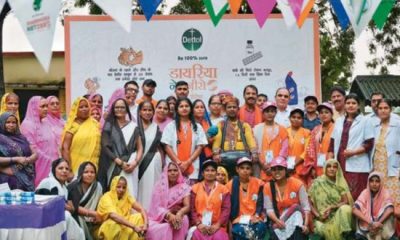Highlights
- Bengaluru has almost 50% of the total COVID-19 cases in Karnataka (80,863)
- During national lockdown, Bengaluru didn’t prepare the manpower: Expert
- People in Bengaluru have complained of lack of hospital beds and treatment
New Delhi: A little over a month ago, Bengaluru was being praised for containing the spread of Coronavirus and the success was being attributed to a war room set-up in city’s corporation headquarters. Bengaluru, the first in the country to set-up a war room was using technology to test, trace and treat COVID-19 patients. The result of this was evident with mere 358 COVID-19 cases by the end of lockdown 4.0 on May 31. In comparison to other big cities like Delhi which had close to 20,000 cases.
However, in June, the number of cases started to increase and as on July 23, the city accounts for around 50 per cent (39,200) of the total cases in Karnataka (80,863). What went wrong and led to a surge in spike in cases? NDTV spoke to medical experts to understand the situation.
Also Read: Bengaluru Using Technology To Test, Trace And Treat COVID-19 Cases In The City
Decoding The Surge In COVID-19 Cases In Bengaluru
On June 1, when the nation went into the unlock phase and relaxations on movement were rolled out, Bengaluru started to see a rise. In the month of June, 4,197 fresh cases were reported and the next two weeks, saw a five-fold increase, taking the total number of cases to 20,969 (as on July 14). In the following five days, over 66 per cent jump in cases was witnessed and the total number shot up to 34,943.
Talking about the sudden rise in cases during the unlock period, Dr Ravindra Mehta, Chief of Pulmonary and Critical Care Medicine at Apollo Hospitals in Bengaluru, said,
Bengaluru has followed the rest of the cities; it’s around 2.5-3 months behind Mumbai, two months behind Delhi and around one and a half month behind Chennai. The Indian Council of Medical Research (ICMR) will not acknowledge it but currently, the city has gone into the community transmission stage. The rise in the numbers is the culmination of unlock, following which the cases increased, containment was not possible and ultimately it hit the community with a rampant spread. The statistics I have seen show the administration was not able to track 1 in 4 people.
Another reason behind a surge in the number of cases is a substantial increase in testing and hence more reporting. In an interview with the news agency ANI, Dr Soumya Swaminathan, Chief Scientist at World Health Organisation (WHO) had said,
The first thing one must know is the epidemiology of the disease, that is where and what is the number of cases per million population and it all depends upon the tests. If we do not test, we are not going to find the case. Reporting of the case alone is not sufficient. We need to know how many tests have been done.
Also Read: World Health Organisation Lauds India’s Effort In COVID-19 Fight, Urges To Focus On Data Management
Until May 31, over 45,000 tests were conducted whereas, in June alone, 70,000 tests were done. The number of tests conducted further increased in July; as on July 22, over 1.26 lakh tests have been done, taking the total number of test close to 2.5 lakh (2,43,673). Talking about the same, Dr Mehta said,
We are testing a lot. Good testing and high prevalence are equivalent to COVID free fall. We can’t blame unlock because it had to happen. Once the prevalence of disease reaches a certain critical level in the community, it’s very difficult to stop it. Over time, it’s not possible to keep up with the containment and tracking.
Dr Giridhara R Babu, Professor and Head, Lifecourse Epidemiology, Indian Institute of Public Health, PHFI, Bengaluru believes that no city is immune to the surge in cases. The only difference is that cities across India are hitting a peak at different times. But there were some problems that fuelled the rise in cases. Talking about the same, Dr Babu, who is also a member of the technical advisory group for COVID-19, Government of Karnataka, and a member of the ICMR Task Force working group on surveillance and research, said,
There were problems with surveillance, testing, contact tracing and tracking, which resulted in several missed cases. Because of a lack of technicians, people have to wait for over three hours to get tested. This is followed by a further delay is analysing and reporting the results, often up to five days. Along with this, one of the most important factors which is prevalent across urban areas in India is negligence towards health. Bruhat Bengaluru Mahanagara Palike (BBMP) spends only 2 per cent of its budget on health and education combined. Apart from this, there have been problems at the administrative level.
Earlier this month, Karnataka Medical Education Minister Dr K Sudhakar had said the surge in the number of COVID-19 cases that the city is witnessing now was expected by July end. Though the surge has come a little early, there is no need to panic. He had said,
We knew there would be a surge as soon as we began lifting the lockdown. But we didn’t have the information that it would grow at this rate. We expected these numbers at the end of July but it has happened a little earlier. But there is no need for panic. We are making all preparations. I am not saying that there are no problems – but we will correct those too.
Bengaluru’s Overburdened Healthcare Infrastructure
According to the official data updated on July 29 (2 pm), government hospitals and medical colleges have dedicated 1,624 beds for COVID-19 patients. Of this, 5463 beds are occupied and the remaining 1,078 are available.
Along with this, private hospitals and medical colleges have provided 11,583 beds to the government for the treatment of COVID-19 patients. Of this, 2,866 are occupied, and 8,717 are vacant.
In addition, 103 beds are available in COVID care centres out of a total of 2,797 beds.
But hospital beds in Bengaluru are rapidly becoming a scarce commodity following the sharp rise in COVID-19 cases. On July 18, the Chief Minister ordered private hospitals in the city to reserve 50 per cent of their beds for COVID-19 patients. The remaining 50 per cent will cater to non-coronavirus patients. The government has also directed the hospital to admit only patients with moderate or severe symptoms. Mild and asymptomatic cases are to be referred to COVID-19 care centres or encouraged to stay in home isolation.
The data shows that Bengaluru has beds to admit COVID-19 patients but media reports and testimonials of citizens paint a different picture. On Sunday (July 19), at 3 AM, a pregnant woman, experiencing labour pain, boarded an auto-rickshaw and rushed from one hospital to another, in search of a medical care. Three hospitals – Srirampura Government Hospital, Victoria Hospital and Vanivilas, which is the maternity wing of Victoria, refused to admit the pregnant woman. All three hospitals said they had no beds to accommodate a pregnant woman ready to deliver a baby. After facing rejection from three hospitals and six hours later, the woman was forced to deliver inside an auto-rickshaw. Unfortunately, the infant passed away.
Also Read: India’s COVID-19 Fatality Rate Progressively Falling, Currently Stands At 2.28 Per Cent: Government
As reported by a news agency PTI, on July 18, a man protested in front of Karnataka Chief Minister BS Yediyurappa’s residence alleging lack of medical care claimed the life of his one-month-old infant girl.
Earlier this month, NDTV reported about a woman in her 50s who tested positive for COVID-19 and had to sit outside her house, for nearly eight hours, waiting for the ambulance, as her husband and son were quarantined inside.
Such instances highlight that the city’s medical infrastructure is crumbling in wake of the surge in number of cases. Talking about the delay in medical attention, Dr Mehta said,
We are repeating the problems of cities that are ahead of us. Similar stories have been reported from Mumbai, Chennai, and Hyderabad. It is a problem because healthcare systems are not ready and equipped to handle the situation. These patients are sent away from both government and private hospitals. The infrastructure itself is not available to handle this.
Further talking about whether city has enough medical infrastructure and manpower, Dr Mehta said,
No, it’s a complete collapse at this point.
When questioned about the media reports, people struggling to find hospital beds and the truth around it, BBMP Mayor M Goutham Kumar told NDTV,
We have enough beds. Not all hospitals are dedicated to COVID care because the city has other kinds of patients as well – delivery cases, heart patients. There are very rare cases where either the patient is unable to reach us or we are unable to reach them on time. I do accept we are under a health emergency. Panic is what people are facing here but we are working towards it. Hotels are being converted into COVID care centre for asymptomatic patients. Every hotel has got a doctor, ventilator and other essentials. We are taking more and more steps.
How Effective Is Bengaluru’s One Week Lockdown?
When the nationwide lockdown was enforced for the first time in March, the idea was to use the period to scale up and prepare healthcare infrastructure to cope with the rise in cases when life resumes after the lockdown. However, it seems, Bengaluru didn’t utilise the lockdown well.
Implementation of lockdown was excellent in containment zones; BBMP sealed areas having infections, strictly restrictions were enforced on movement. There was no local circulation during the lockdown. Therefore, reducing the speed of transmission which meant that the first part of the lockdown was taken care of well. The second part is to prepare and I don’t think Bengaluru has done well in that section. All the planning in terms of manpower is happening now. But this is not unique to Bengaluru. It is common in all urban areas like Mumbai tried to mobilise resources by hiring nurses and doctors, explains Dr Babu.
Keeping in mind the rise in cases, various cities and states are opting for a re-lockdown. Bengaluru too resorted to the same measure and imposed a week-long lockdown till July 22 (5 am). Lockdowns work in terms of reducing the number of cases and are meant to buy time to fix gaps in the system. So the decision to implement a week long lockdown raises the question of how will it be useful in helping Bengaluru tide over the current bottlenecks?
Elaborating on how the week-long lockdown will help, Dr Mehta said,
Lockdown helps in future cases. What we are seeing right now is the people who have got the infection in the last 7-10 days. Currently the lockdown, if at all it has any minimal effect, is going to be on the cases which will come 10 days from now. Secondly, it will be used to prepare healthcare further. It’s all damage control now.
Revenue Minister R Ashok had shared similar thoughts and said,
The limited lockdown was to catch up with the backlog of cases, trace primary contacts and create medical infrastructure.
But is the one week lockdown enough to prepare for the future cases? Giving out the reason to enforce a weeklong lockdown and the plan of action, BBMP Mayor M Goutham Kumar told NDTV,
One week lockdown is to analyse the ground reality and decide what can be done for the citizens. The city has been divided into eight zones and each zone is monitored by individual ministers. Nodal officers have been appointed at the constituency level and every booth has three officials to monitor the lockdown.
Also Read: COVID-19: 8,800 Booth Level Task Force Committees To Be Set Up In Bengaluru
To coordinate the fight against the #Covid19 pandemic, eight Zonal officers have been appointed for each #BBMP zone.
ಬೆಂಗಳೂರಿನಲ್ಲಿ #ಕೋವಿಡ್19 ಸೋಂಕು ಹರಡುವಿಕೆಯನ್ನು ಪರಿಣಾಮಕಾರಿಯಾಗಿ ನಿಯಂತ್ರಣ ಮಾಡಲು #ಬಿಬಿಎಂಪಿ ಯ 8 ವಲಯಗಳಿಗೆ ಸಂಯೋಜಕರನ್ನು ನೇಮಿಸಲಾಗಿದೆ.#Bengaluru #BBMPFightsCovid19 pic.twitter.com/00tKvXHsPW
— Gaurav Gupta (@BBMPCOMM) July 9, 2020
The lockdown has now been lifted as Karnataka Chief Minister B S Yediyurappa believes lockdown is not a solution. On July 21, CM had said,
We have to fight COVID-19 while maintaining a stable economy. Lockdown is not the solution, now restrictions will be placed only in containment zones.
The Way Forward For Bengaluru In Its Fight Against The Pandemic
According to Dr Mehta, a multipronged approach is required to tide over the crisis. He believes steps are required to ensure asymptomatic and patients with mild symptoms get assistance at either home or COVID care centres. This way, hospitals can be reserved for more serious patients. Apart from this, he suggests,
A continued maximum attempt at prevention or containment and tracking and testing is required. Secondly, build a public and private partnership of a viable nature with all stakeholders, especially private, to plan for the next few months now.
Also Read: Strict Precautions Are Needed To Control COVID-19 In Bengaluru: Home Minister Basavaraj Bommai
Dr Babu suggests resolving the issue of poor tracking at the laboratory level itself. He believes, as soon as the samples are collected, the information should be shared with state health authorities and urban health centres so that they can track the contacts. Along with this, if someone has tested positive, the information should be provided to the local medical officer, so that they can take up the task of contact tracing.
Immediate repatriation of link workers to health department, hiring ANMs (Auxiliary Nursing Midwifery), additional medical officers and strengthening public health wing with complete autonomy can help in contact tracing, said Dr Babu.
He also suggests taking inputs from the people working at the ground level. “Not just problems, they also have solutions”, Dr Babu noted in a tweet. And to solve the problem of doctors and other allied staff resigning or not showing up, Dr Babu recommends providing term insurance, medical insurance and assurance of beds to doctors if they are infected with COVID-19.
#BBMP updates: People working at ground level should be given an opportunity to speak up during meetings about the “real” problems they are facing. Encouraging field staff to speak up will help. Not just problems, they also have solutions. It is time for reason & bold steps. 1/n
— Dr Giridhara R Babu (@epigiri) July 11, 2020
Also Read: Karnataka Medical Education Minister Asks Zonal Officers To Follow Strategic Plan For COVID-19
NDTV – Dettol Banega Swasth India campaign is an extension of the five-year-old Banega Swachh India initiative helmed by Campaign Ambassador Amitabh Bachchan. It aims to spread awareness about critical health issues facing the country. In wake of the current COVID-19 pandemic, the need for WASH (Water, Sanitation and Hygiene) is reaffirmed as handwashing is one of the ways to prevent Coronavirus infection and other diseases. The campaign highlights the importance of nutrition and healthcare for women and children to prevent maternal and child mortality, fight malnutrition, stunting, wasting, anaemia and disease prevention through vaccines. Importance of programmes like Public Distribution System (PDS), Mid-day Meal Scheme, POSHAN Abhiyan and the role of Aganwadis and ASHA workers are also covered. Only a Swachh or clean India where toilets are used and open defecation free (ODF) status achieved as part of the Swachh Bharat Abhiyan launched by Prime Minister Narendra Modi in 2014, can eradicate diseases like diahorrea and become a Swasth or healthy India. The campaign will continue to cover issues like air pollution, waste management, plastic ban, manual scavenging and sanitation workers and menstrual hygiene.
[corona_data_new]
(This story has not been edited by NDTV staff and is auto-generated from a syndicated feed.)































